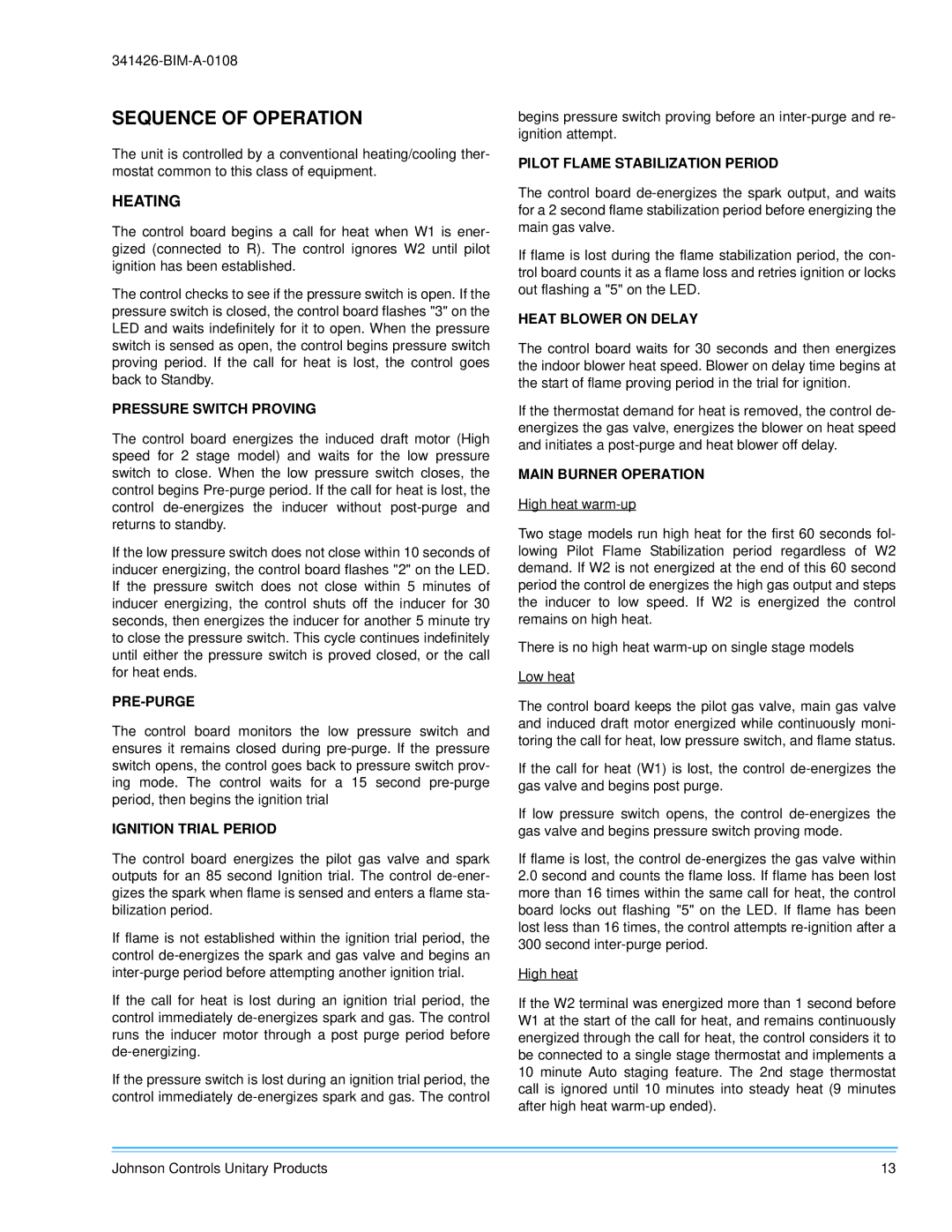SEQUENCE OF OPERATION
The unit is controlled by a conventional heating/cooling ther- mostat common to this class of equipment.
HEATING
The control board begins a call for heat when W1 is ener- gized (connected to R). The control ignores W2 until pilot ignition has been established.
The control checks to see if the pressure switch is open. If the pressure switch is closed, the control board flashes "3" on the LED and waits indefinitely for it to open. When the pressure switch is sensed as open, the control begins pressure switch proving period. If the call for heat is lost, the control goes back to Standby.
PRESSURE SWITCH PROVING
The control board energizes the induced draft motor (High speed for 2 stage model) and waits for the low pressure switch to close. When the low pressure switch closes, the control begins
If the low pressure switch does not close within 10 seconds of inducer energizing, the control board flashes "2" on the LED. If the pressure switch does not close within 5 minutes of inducer energizing, the control shuts off the inducer for 30 seconds, then energizes the inducer for another 5 minute try to close the pressure switch. This cycle continues indefinitely until either the pressure switch is proved closed, or the call for heat ends.
PRE-PURGE
The control board monitors the low pressure switch and ensures it remains closed during
IGNITION TRIAL PERIOD
The control board energizes the pilot gas valve and spark outputs for an 85 second Ignition trial. The control
If flame is not established within the ignition trial period, the control
If the call for heat is lost during an ignition trial period, the control immediately
If the pressure switch is lost during an ignition trial period, the control immediately
begins pressure switch proving before an
PILOT FLAME STABILIZATION PERIOD
The control board
If flame is lost during the flame stabilization period, the con- trol board counts it as a flame loss and retries ignition or locks out flashing a "5" on the LED.
HEAT BLOWER ON DELAY
The control board waits for 30 seconds and then energizes the indoor blower heat speed. Blower on delay time begins at the start of flame proving period in the trial for ignition.
If the thermostat demand for heat is removed, the control de- energizes the gas valve, energizes the blower on heat speed and initiates a
MAIN BURNER OPERATION
High heat
Two stage models run high heat for the first 60 seconds fol- lowing Pilot Flame Stabilization period regardless of W2 demand. If W2 is not energized at the end of this 60 second period the control de energizes the high gas output and steps the inducer to low speed. If W2 is energized the control remains on high heat.
There is no high heat
Low heat
The control board keeps the pilot gas valve, main gas valve and induced draft motor energized while continuously moni- toring the call for heat, low pressure switch, and flame status.
If the call for heat (W1) is lost, the control
If low pressure switch opens, the control
If flame is lost, the control
2.0second and counts the flame loss. If flame has been lost more than 16 times within the same call for heat, the control board locks out flashing "5" on the LED. If flame has been lost less than 16 times, the control attempts
High heat
If the W2 terminal was energized more than 1 second before W1 at the start of the call for heat, and remains continuously energized through the call for heat, the control considers it to be connected to a single stage thermostat and implements a 10 minute Auto staging feature. The 2nd stage thermostat call is ignored until 10 minutes into steady heat (9 minutes after high heat
Johnson Controls Unitary Products | 13 |
